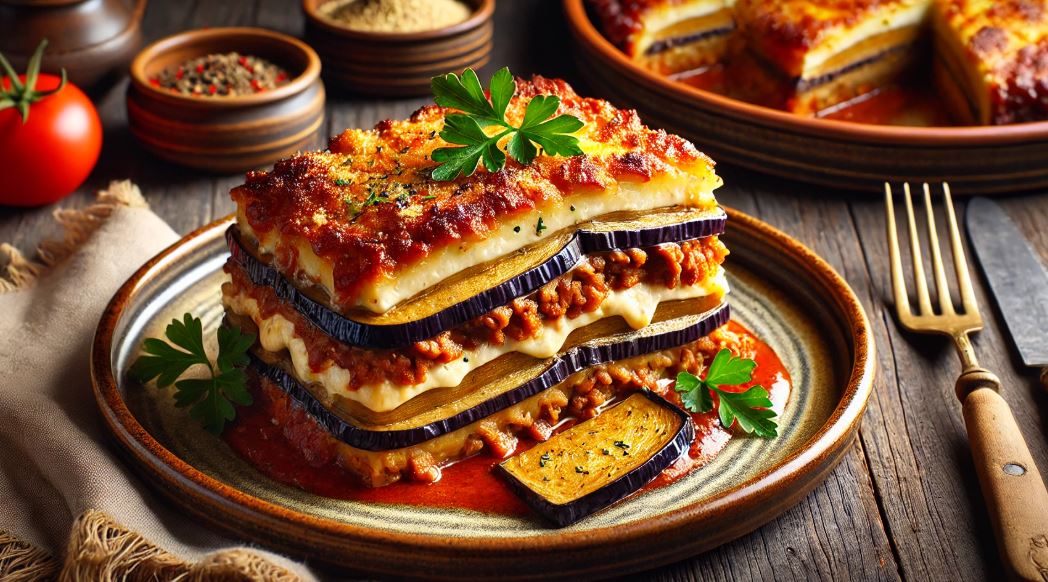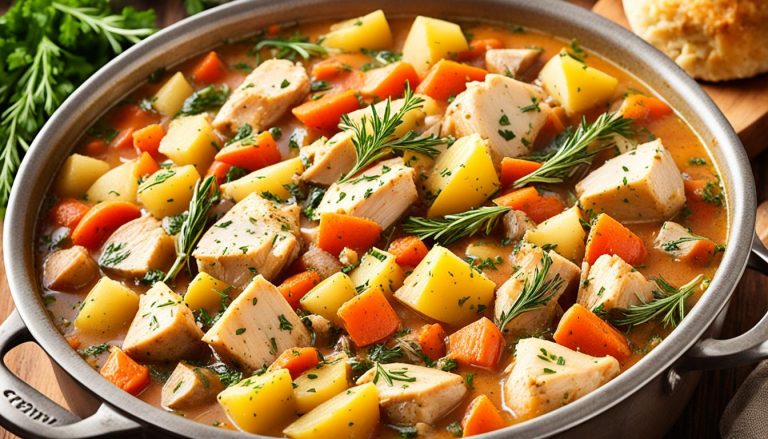As someone who has spent years experimenting with Mediterranean classics, I’ve found that few dishes are as satisfying as a well-prepared Moussaka. Rich, layered, and bursting with flavour, Moussaka has rightfully earned its place in the heart of British home cooking.
In this guide, I’ll take you through a traditional yet modern Moussaka recipe, crafted with authentic ingredients and tailored for a UK kitchen without losing its Greek soul.
What is Moussaka?

Moussaka is a timeless Mediterranean classic, deeply rooted in Greek cuisine yet embraced widely across Europe and the Middle East. This hearty, layered casserole is known for its rich combination of tender minced meat, silky aubergines, and a velvety béchamel sauce, all baked to golden perfection.
Its origins trace back to the Ottoman Empire, but it is the Greek interpretation that has become a household favourite.
The beauty of Moussaka lies in its structure, distinct layers of flavours that meld together in the oven. Traditionally, minced lamb or beef is slow-cooked with onions, garlic, tomatoes, and fragrant spices like cinnamon and oregano.
This forms the base, which is then layered with slices of fried or roasted aubergine and sometimes potato. Finally, a thick layer of creamy béchamel sauce is spread on top, sprinkled with grated cheese, and baked until bubbly and golden.
Key Characteristics of Moussaka
- Multi-layered casserole with meat and aubergine.
- Topped with a luxurious béchamel sauce.
- Commonly cooked with lamb but often substituted with beef.
- Perfect as a main dish for family dinners or special gatherings.
In the UK, Moussaka has found its place among comfort foods, with local chefs adding their own twists while respecting its Greek origins.
Ingredients for Moussaka Recipe UK
A perfect Moussaka begins with high-quality ingredients. Below is a detailed breakdown of the ingredients you’ll need:
| Ingredients | Specifications |
| Minced Lamb or Beef | 500g, preferably 20% fat for richness |
| Onion (finely chopped) | 1 large |
| Garlic Cloves (minced) | 2–3 cloves |
| Chopped Tomatoes | 400g tin |
| Tomato Paste | 2 tablespoons |
| Red Wine | 100ml (optional for depth of flavour) |
| Cinnamon Stick | 1 piece |
| Dried Oregano | 1 teaspoon |
| Salt and Pepper | To taste |
| Aubergine (Eggplant) | 2 large, sliced 1cm thick |
| Potato (optional) | 1–2 large, sliced thinly |
| Butter | 50g |
| Plain Flour | 50g |
| Milk | 500ml |
| Nutmeg | A pinch |
| Egg Yolk | 1 large |
| Grated Cheese (Parmesan or Kefalotyri) | 50g |
Optional: Fresh parsley for garnish, breadcrumbs for added crunch on top.
Step-by-Step Guide to Cooking Moussaka to Perfection
1. Layering

- Grease a large baking dish.
- Start with a layer of potatoes, if using, followed by a layer of aubergines.
- Spread half of the meat sauce evenly over the aubergines.
- Add another layer of aubergines, then the remaining meat sauce.
- Top with a final layer of aubergines.
2. Adding the Béchamel

- Spread the béchamel sauce evenly over the top of the meat and aubergines.
- Sprinkle with grated cheese and breadcrumbs for a crunchy, golden topping.
3. Baking

- Preheat your oven to 180°C (350°F).
- Bake for 40–45 minutes or until the top is golden and the edges are bubbling.
4. Resting Time

- Let the Moussaka rest for 15–20 minutes before cutting. This helps the layers set beautifully.
How to Prepare the Perfect Moussaka Layers?
One of the secrets to a beautifully structured Moussaka is the careful preparation of each layer. Here’s how to do it:
1. Preparing the Meat Layer
- Heat a tablespoon of olive oil in a large pan.
- Sauté the chopped onion and garlic until soft and fragrant.
- Add the minced lamb or beef, breaking it up as it cooks.
- Cook until browned, then stir in the chopped tomatoes, tomato paste, red wine (if using), and the cinnamon stick.
- Sprinkle in the dried oregano, salt, and pepper.
- Allow the mixture to simmer for 20–25 minutes until it thickens and the flavours meld together.
- Remove the cinnamon stick and set the meat sauce aside.
2. Preparing the Vegetables
- Slice the aubergines and potatoes (if using) about 1cm thick.
- Lightly salt the aubergines and let them sit for 10–15 minutes to remove excess moisture.
- Pat dry with a paper towel.
- Either fry them in olive oil until golden or bake them for a healthier option.
- If using potatoes, lightly cook them by boiling or baking before layering.
3. Making the Béchamel Sauce
- Melt butter in a medium saucepan over medium heat.
- Stir in the flour and cook for 2–3 minutes, whisking constantly to avoid lumps.
- Gradually add the milk, stirring continuously until the sauce thickens.
- Stir in the nutmeg, salt, and grated cheese.
- Remove from heat, allow to cool slightly, then whisk in the egg yolk for extra richness.
What’s the Difference Between Greek Moussaka and British Moussaka?
While both Greek and British versions of Moussaka share a common foundation of minced meat, aubergines, and béchamel sauce, there are distinct differences in their preparation and ingredients.
Greek Moussaka traditionally uses lamb and is heavily spiced with cinnamon and oregano, staying close to its Mediterranean roots. The dish is layered with fried aubergines and sometimes courgettes, with a thick béchamel topping.
In contrast, British adaptations often substitute lamb for beef mince, making it more accessible and familiar to local palates. Potatoes are also commonly added to the layers, contributing to a heartier, more filling dish.
The seasoning tends to be milder, with a focus on savoury notes rather than the aromatic spices found in Greek versions. This makes British Moussaka slightly less bold in flavour but more aligned with classic comfort food.
Can You Make Moussaka Vegetarian or Vegan?
Yes, Moussaka can easily be adapted for vegetarian or vegan diets without sacrificing its rich, layered goodness. For a vegetarian version, the minced meat is often replaced with lentils or a hearty mix of mushrooms, providing a similar texture and depth of flavour.
Many recipes also use a medley of vegetables such as courgettes, carrots, and bell peppers to bulk up the filling.
For a vegan version, the béchamel sauce is swapped with a plant-based alternative. Almond milk or oat milk thickened with flour or cornstarch works wonderfully, while nutritional yeast adds a cheesy flavour.
Vegan cheese can also be sprinkled on top before baking for that classic golden crust. This version remains true to the essence of Moussaka while being entirely plant-based and equally satisfying.
| Nutrient | Per Serving (Approx.) |
| Calories | 430 kcal |
| Protein | 23g |
| Carbohydrates | 20g |
| Fats | 28g |
| Fibre | 5g |
| Sodium | 340mg |
Tips and Tricks for a Perfectly Baked Moussaka
Achieving the perfect Moussaka is all about technique and patience. Here are some tips to ensure each layer is cooked to perfection and the final dish is a stunning success:
- Salt the Aubergines: Before cooking, lightly salt the aubergine slices and let them rest for about 15 minutes. This draws out excess moisture and prevents them from becoming soggy during baking.
- Fry or Bake the Vegetables: While frying aubergines gives them a richer taste, baking them is a healthier option that still results in a golden finish.
- Let it Rest Before Serving: After removing Moussaka from the oven, allow it to rest for at least 15–20 minutes. This helps the layers set, making it easier to cut and serve.
- Sprinkle with Cinnamon: Adding a dash of cinnamon to the meat sauce elevates the dish’s Mediterranean flavour.
- Don’t Rush the Béchamel: Slow cooking over medium heat ensures a smooth, creamy texture without lumps.
Side Dishes That Pair Well with Moussaka
The rich, hearty flavours of Moussaka are beautifully complemented by light and fresh side dishes. Here are some popular choices:
- Greek Salad: A crisp salad with fresh tomatoes, cucumber, red onion, olives, and feta cheese, drizzled with olive oil and oregano.
- Tzatziki with Pita: This creamy yogurt dip made with cucumber, garlic, and dill pairs perfectly with warm pita bread.
- Roasted Vegetables: Mediterranean vegetables like peppers, courgettes, and onions are ideal companions.
- Fresh Crusty Bread: Perfect for mopping up the rich meat sauce and béchamel.
Chef Variations of Moussaka Recipes

1. BBC Good Food’s Classic Moussaka
This version by BBC Good Food stays true to traditional Greek roots while making it accessible to a British audience. It features a rich, slow-cooked meat sauce made with either lamb or beef, layered generously with fried aubergines.
The crowning glory is a thick, cheesy béchamel sauce that is baked until golden brown. The recipe emphasizes simplicity and flavour, making it perfect for family dinners or Sunday roasts. Its straightforward method and familiar ingredients make it a popular choice in UK kitchens.
2. Don’t Go Bacon My Heart’s British Twist
This rendition by Don’t Go Bacon My Heart adds a unique British flair to the classic Moussaka dish by incorporating bacon into the meat sauce. This twist introduces a smoky depth of flavour, elevating the richness of the minced meat.
While still maintaining the traditional layers of aubergine and béchamel, the addition of bacon provides a delightful contrast to the sweet notes of cinnamon and oregano. It’s a hearty, comforting version that bridges Greek tradition with British tastes.
3. My Greek Dish’s Authentic Greek Moussaka
At My Greek Dish, the recipe is all about authenticity and bold Mediterranean spices. This version uses layers of well-seasoned lamb or beef, paired with aubergines that are pre-fried to achieve a slightly crispy texture.
The béchamel sauce is thick and well-browned during baking, creating a lovely crust that contrasts beautifully with the softness of the layers beneath. This recipe pays homage to classic Greek techniques, ensuring a robust and genuine flavour profile.
4. The Happy Foodie’s Layered Moussaka Delight
The Happy Foodie introduces a bit of culinary flair to its Moussaka recipe. A notable difference is the addition of red wine to the meat sauce, lending depth and complexity to the flavour.
The layers are meticulously arranged with potatoes, aubergines, and a generous spread of meat sauce. The final touch is a béchamel that’s creamy yet not overly heavy, making it an elegant dish for dinner parties or special occasions.
5. James Martin’s Lamb Moussaka Recipe
Celebrated chef James Martin brings a touch of luxury to the traditional dish with his Lamb Moussaka recipe. His version is robust and hearty, focusing on layers of lamb cooked with aromatic spices, including cinnamon and bay leaves.
The meat is slow-cooked for tenderness, and the aubergines are roasted for a richer flavour. Martin’s recipe includes a thicker meat layer and a creamy, perfectly browned béchamel that seals in the juices and adds a velvety finish.
Conclusion
Crafting a traditional Moussaka with a modern twist is a rewarding culinary journey. From the depth of the meat sauce to the silky béchamel topping, each layer tells a story of Mediterranean comfort and flavour.
Whether you’re making it for a Sunday dinner or to impress guests, this recipe is a delicious way to bring a touch of Greece into your UK home. It’s hearty, satisfying, and unforgettable.
Frequently Asked Questions
What type of meat works best in a traditional Moussaka?
Lamb is the traditional choice due to its rich flavour, but beef is a popular substitute in the UK. For a leaner version, you can also use a mix of beef and pork mince.
Can Moussaka be made ahead of time?
Yes, Moussaka is ideal for meal prep. You can assemble it a day in advance, store it in the fridge, and bake it when needed. It also freezes well for up to 3 months.
How do I prevent my béchamel sauce from becoming lumpy?
Constant whisking while gradually adding warm milk to the flour and butter mixture is key. Also, avoid high heat which can cause curdling or clumping.
What can I use instead of aubergine?
Courgettes or thinly sliced mushrooms make great alternatives. These provide a similar texture and absorb the flavours of the meat sauce beautifully.
How do I serve Moussaka for the best results?
Let the dish rest for at least 15 minutes after baking. This helps it set and makes slicing easier. Pair with a crisp Greek salad and crusty bread for a complete meal.

Moussaka Recipe UK
Ingredients
- 500 g Minced Lamb or Beef preferably 20% fat for richness
- 1 large Onion finely chopped
- 2–3 Garlic Cloves minced
- 400 g Chopped Tomatoes tin
- 2 tbsp Tomato Paste
- 100 ml Red Wine optional for depth of flavour
- 1 piece Cinnamon Stick
- 1 tsp Dried Oregano
- Salt and Pepper To taste
- 2 large Aubergine Eggplant , sliced 1cm thick
- 1–2 large Potato optional , sliced thinly
- 50 g Butter
- 50 g Plain Flour
- 500 ml Milk
- Nutmeg A pinch
- 1 large Egg Yolk
- 50 g Grated Cheese Parmesan or Kefalotyri
Instructions
- Grease a large baking dish.1 large Onion, 2–3 Garlic Cloves, 400 g Chopped Tomatoes
- Start with a layer of potatoes, if using, followed by a layer of aubergines.2 large Aubergine, 1–2 large Potato
- Spread half of the meat sauce evenly over the aubergines.2 tbsp Tomato Paste, 100 ml Red Wine, 1 piece Cinnamon Stick
- Add another layer of aubergines, then the remaining meat sauce.1 tsp Dried Oregano, Salt and Pepper, 50 g Butter, 1 large Egg Yolk
- Top with a final layer of aubergines.
- Spread the béchamel sauce evenly over the top of the meat and aubergines.500 g Minced Lamb or Beef
- Sprinkle with grated cheese and breadcrumbs for a crunchy, golden topping.50 g Plain Flour, 500 ml Milk, 50 g Grated Cheese, Nutmeg
- Preheat your oven to 180°C (350°F).
- Bake for 40–45 minutes or until the top is golden and the edges are bubbling.
- Let the Moussaka rest for 15–20 minutes before cutting. This helps the layers set beautifully.









